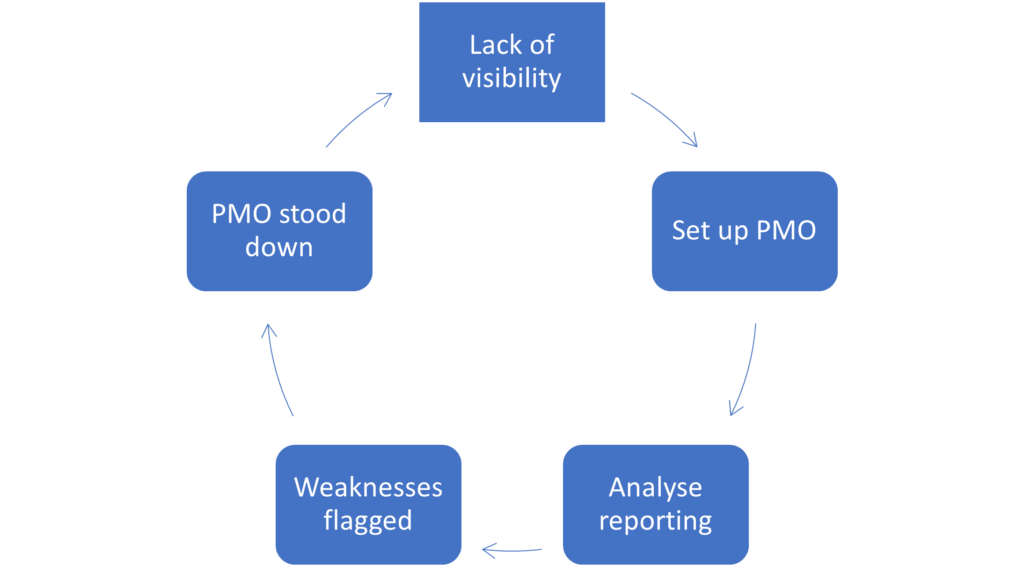There’s an ongoing phenomenon in the modern Project Management Office known as the ‘PMO cycle of death’. As ominous as it sounds, this cycle, coupled with undervalued project management, is responsible for 50% of PMO failures.
What is the PMO Cycle of Death?
The Cycle of Death repeated by so many PMOs across the globe looks something like this:
An organisation is running multiple projects of all sizes managed by a number of PMs possessing varied project management maturity levels. With minimal transparency across the projects and no clear picture of their progress, executive stakeholders get nervous and hire a consultancy to set up a PMO.
The PMO promises to drive consistency and visibility by bringing professional project managers and citizen PMs into a uniform method, expected to use the same tools regardless of their comfort or experience levels.
Post-project metrics and reports are gathered, yielding underwhelming results in project improvement. Executives begin to doubt the necessity of the PMO, demanding more assurance, so they increase the vigour of the PMO and subsequently deem the process as too cumbersome. When complaints are raised across the organisation, the PMO is subverted, and after typically 2-3 years it is completely disbanded.
When a new executive enters, so does a new PMO. Everything done in the past few years vanishes into the ether, setting the Cycle of Death back in motion. This common cycle is concerning for an organisation, but what sets this cycle in motion, and why do some PMO’s fail to unleash their full potential?

A roadmap to success
To map out a path to PPM success, it’s important to first understand why organisations set up PMOs in the first place. In the simplest terms, every organisation has goals to achieve requiring projects that will help them achieve those goals. To ensure effective outcomes of complex project challenges, they need to be certain that their projects are properly aligned with the various stakeholders of those goals, across all project management maturity levels.
A major factor attributed to faulty PMOs is the lack of time spent identifying the purpose and type of PMO that can be understood and agreed upon by key stakeholders and PMs from the outset. Not all PMO’s exist for the same reason.
In fact, there are different types of PMOs for different purposes. That said, there is no set standard or template for determining the type of PMO executives should set up within their organisations. With PMOs, a ‘one size fits all’ mentality is a quick entry to the Cycle of Death. Every business must tailor their PMO to support their unique organisational needs at a level that all PPM leaders can embrace and from which it can gain the most benefit.
Questions to consider when choosing a type of PMO are:
- Is it an administrative function: to maintain standards, centralise reporting, monitor progress and spend?
- Is it for quality control; to standardise processes, manage risk, reduce errors?
- Is it to ensure the achievement of business goals?
- Is it to increase agility, adaptability, and streamlining of project investments?
Based on one of the purposes above, an organisation can then decide on the type of PMO that will best meet those needs and accelerate its maturity journey.
Types of PMOs fit for purpose
Though there are many different names for different types of PMOs, there are three main types that cover most organisations’ needs.
Supportive PMO – The supportive PMO provides mentoring, training, information, and support while encouraging autonomy. Supportive PMOs will often provide suggestions in maintaining project standards but allow each project manager to decide which methods they will use to meet those standards.
Controlling PMO – To ensure every team in an organisation is on the same page, a controlling PMO may fit the bill. This type of PMO works best when processes need to be reined in and analysed through quality control. Unlike a supportive PMO, a controlling PMO expects project managers of all maturity levels to follow the set guidelines without straying from the program. Controlling PMOs can also review projects to ensure they’re compliant. Directive PMO – The directive PMO staffs projects directly rather than taking a holistic view of projects that come from various areas of the business. It commands the project elements, coordinating planning tasks like resource allocation, risk management, and project scoping. Because the PMO is managing most large initiatives, these project management offices tend to staff many more employees.
Work top down
Based on Sensei’s surveys of its clients the number one cause of PMO failure is misalignment to executive needs. Executives focus on delivering the strategic goals of the organisation. Therefore, it’s critical to start by aligning with what the executives need, by talking to them. This makes your PMO relevant from a strategic perspective. Working bottom up to convince the executives of why they need a PMO is difficult, as it may focus on best practice when they value something very different. And that is usually visibility, trustworthy and current information, adaptability and risk reduction.
Get the data right
Your PMO now exists with an agreed purpose. And you have the support of executives as you are helping them to achieve business critical outcomes. The next step towards success is to get the data right. Design out the reporting needed that actually helps those executives make decisions, trace where that data comes from, and build your processes around making it easy to gather that information. Instead of putting in project management process for the sake of best practice, as your organisation may need its own type of practice to cover a range of project management needs, focus on getting the hierarchy of data designed and in place. That supports the executives and provides a guide as to which processes will be relevant.
Start simple and keep it realistic
Implementing a successful PMO does not have to be a daunting task, but it does require due diligence, the correct level of sponsorship and an understanding of a business’s strategy, purpose and its responsibility to give every PM at every maturity level the opportunity to work in an organised manner in their own way.
Project and portfolio management has proven that there is always a better way to do what you’re doing now or in the future, and by implementing a solution like Altus, businesses can allow all maturity levels to work the way want, perpetuate a long-standing functional PMO and avoid the dreaded Cycle of Death.
Not sure where to start? We offer a complimentary Envision Workshop. Get in touch here 👉 Get in touch – Sensei Project Solutions
By Ryan Darby
With over 18 years in PPM and Work Management Ryan has developed into a well-rounded professional who can always be approached and asked for advice. With experience in over 100 PPM implementations and Ryan’s excellent people skills, he is always able to provide quality advice and direction. Ryan is an industry standard expert on all levels of PMI, PMO and Scaled Agile.



